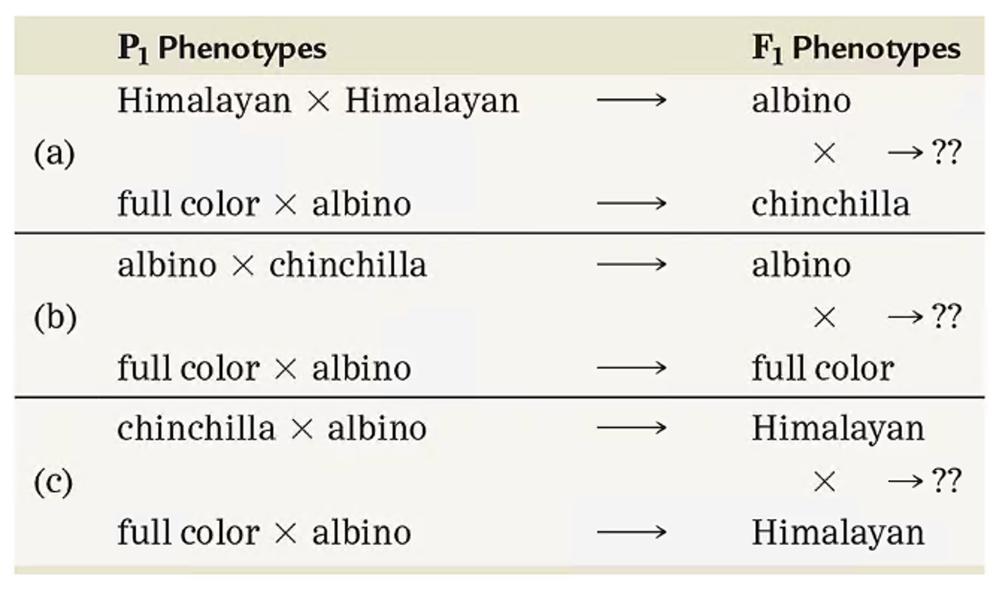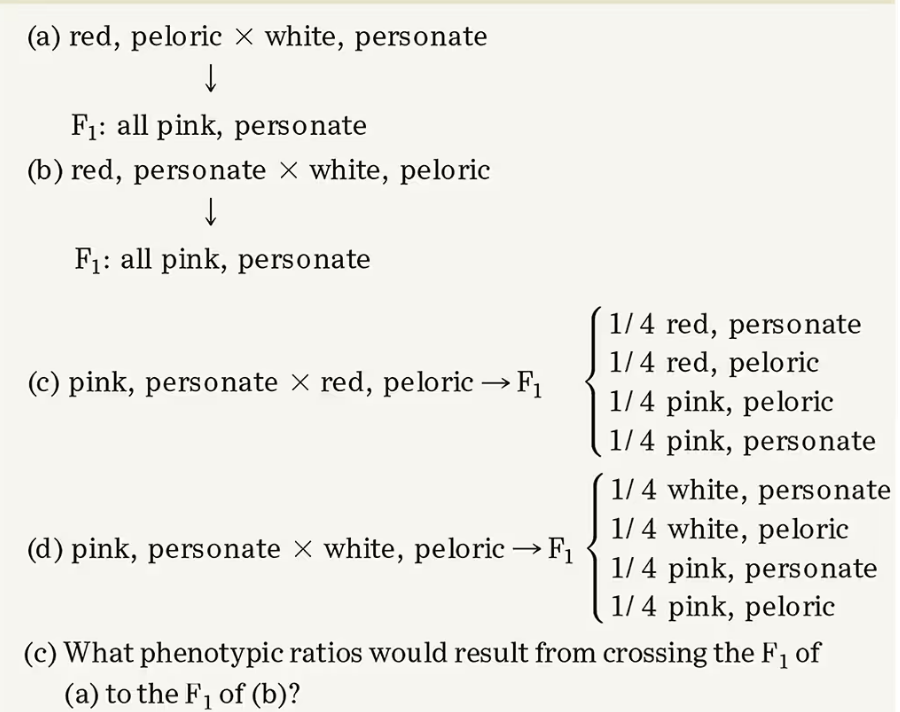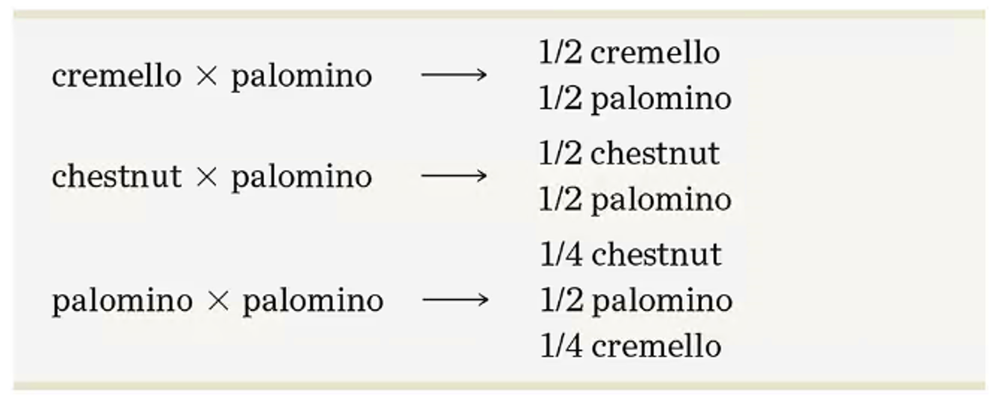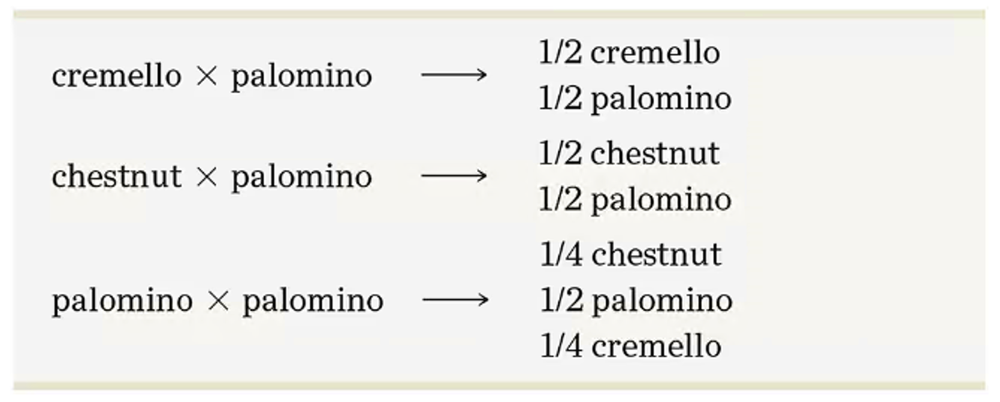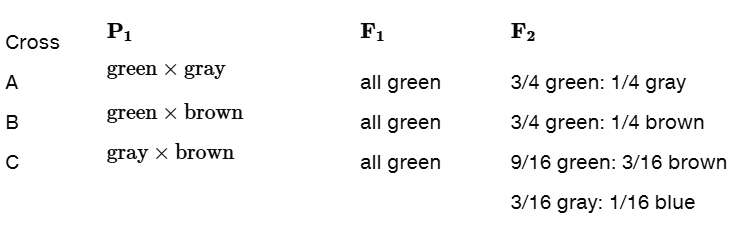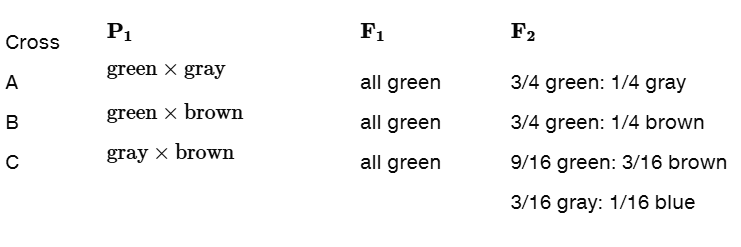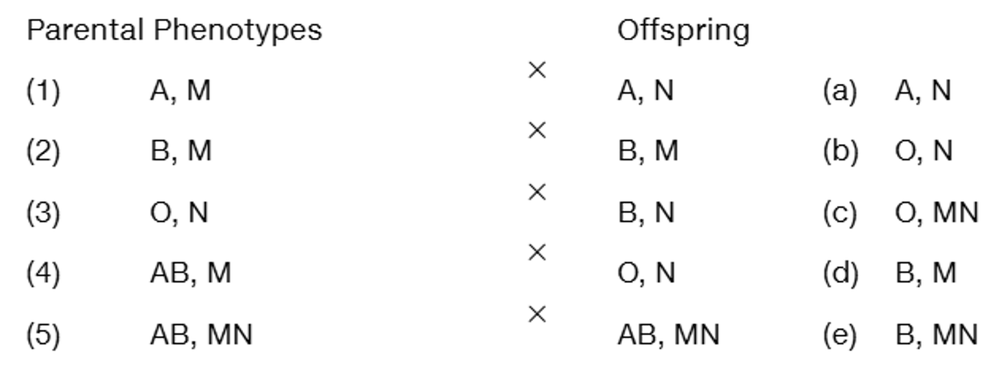 Back
BackProblem 11
In rabbits, a series of multiple alleles controls coat color in the following way: C is dominant to all other alleles and causes full color. The chinchilla phenotype is due to the cch allele, which is dominant to all alleles other than C. The ch allele, dominant only to (albino), results in the Himalayan coat color. Thus, the order of dominance is C > cch > ch > ca. For each of the following three cases, the phenotypes of the P1 generations of two crosses are shown, as well as the phenotype of one member of the F1 generation.
For each case, determine the genotypes of the P1 generation and the F1 offspring, and predict the results of making each indicated cross between F1 individuals.
Problem 12
Three gene pairs located on separate autosomes determine flower color and shape as well as plant height. The first pair exhibits incomplete dominance, where the color can be red, pink (the heterozygote), or white. The second pair leads to personate (dominant) or peloric (recessive) flower shape, while the third gene pair produces either the dominant tall trait or the recessive dwarf trait. Homozygous plants that are red, personate, and tall are crossed to those that are white, peloric, and dwarf. Determine the F₁ genotype(s) and phenotype(s). If the F₁ plants are interbred, what proportion of the offspring will exhibit the same phenotype as the F₁ plants?
Problem 13
Flower color may be red, white, or pink, and flower shape may be personate or peloric. For the following crosses, determine the P₁ and F₁ genotypes:
Problem 14a
Horses can be cremello (a light cream color), chestnut (a brownish color), or palomino (a golden color with white in the horse's tail and mane). Of these phenotypes, only palominos never breed true.
From the results given above, determine the mode of inheritance by assigning gene symbols and indicating which genotypes yield which phenotypes.
Problem 14b
Horses can be cremello (a light cream color), chestnut (a brownish color), or palomino (a golden color with white in the horse's tail and mane). Of these phenotypes, only palominos never breed true.
Predict the F1 and F2 results of many initial matings between cremello and chestnut horses.
Problem 15a
With reference to the eye color phenotypes produced by the recessive, autosomal, unlinked brown and scarlet loci in Drosophila, predict the F₁ and F₂ results of the following P₁ crosses. (Recall that when both the brown and scarlet alleles are homozygous, no pigment is produced, and the eyes are white.)
Wild type x White
Problem 15b
With reference to the eye color phenotypes produced by the recessive, autosomal, unlinked brown and scarlet loci in Drosophila, predict the F₁ and F₂ results of the following P₁ crosses. (Recall that when both the brown and scarlet alleles are homozygous, no pigment is produced, and the eyes are white.)
Wild type x Scarlet
Problem 15c
With reference to the eye color phenotypes produced by the recessive, autosomal, unlinked brown and scarlet loci in Drosophila, predict the F₁ and F₂ results of the following P₁ crosses. (Recall that when both the brown and scarlet alleles are homozygous, no pigment is produced, and the eyes are white.)
Brown x White
Problem 16a
Pigment in mouse fur is only produced when the C allele is present. Individuals of the cc genotype are white. If color is present, it may be determined by the A, a alleles. AA or Aa results in agouti color, while aa results in black coats. What F₁ and F₂ genotypic and phenotypic ratios are obtained from a cross between AACC and aacc mice?
Problem 16b
Pigment in mouse fur is only produced when the C allele is present. Individuals of the cc genotype are white. If color is present, it may be determined by the A, a alleles. AA or Aa results in agouti color, while aa results in black coats. In three crosses between agouti females whose genotypes were unknown and males of the aacc genotype, the following phenotypic ratios were obtained:
(1) 8 agouti
(2) 9 agouti
(3) 4 agouti, 8 white 10 black, 5 black, 10 white
Problem 17a
In rats, the following genotypes of two independently assorting autosomal genes determine coat color:
A third gene pair on a separate autosome determines whether or not any color will be produced. The CC and Cc genotypes allow color according to the expression of the A and B alleles. However, the cc genotype results in albino rats regardless of the A and B alleles present. Determine the F₁ phenotypic ratio of the following crosses:
AAbbCC×aaBBcc
Problem 17c
In rats, the following genotypes of two independently assorting autosomal genes determine coat color:
A third gene pair on a separate autosome determines whether or not any color will be produced. The CC and Cc genotypes allow color according to the expression of the A and B alleles. However, the cc genotype results in albino rats regardless of the A and B alleles present. Determine the F₁ phenotypic ratio of the following crosses:
AaBbCc×AaBbcc
Problem 17d
In rats, the following genotypes of two independently assorting autosomal genes determine coat color:
A third gene pair on a separate autosome determines whether or not any color will be produced. The CC and Cc genotypes allow color according to the expression of the A and B alleles. However, the cc genotype results in albino rats regardless of the A and B alleles present. Determine the F₁ phenotypic ratio of the following crosses: AaBBCc×AaBBCc
Problem 17e
In rats, the following genotypes of two independently assorting autosomal genes determine coat color:
A third gene pair on a separate autosome determines whether or not any color will be produced. The CC and Cc genotypes allow color according to the expression of the A and B alleles. However, the cc genotype results in albino rats regardless of the A and B alleles present. Determine the F₁ phenotypic ratio of the following crosses:
AABbCc×AABbcc
Problem 18a
Given the inheritance pattern of coat color in rats described in Problem 17, predict the genotype and phenotype of the parents who produced the following offspring:
9/16 gray: 3/16 yellow: 3/16 black: 1/16 cream
Problem 18b
Given the inheritance pattern of coat color in rats described in Problem 17, predict the genotype and phenotype of the parents who produced the following offspring:
9/16 gray: 3/16 yellow: 4/16 albino
Problem 18c
Given the inheritance pattern of coat color in rats described in Problem 17, predict the genotype and phenotype of the parents who produced the following offspring: 27/64 gray:
16/64 albino: 9/64 yellow: 9/64 black: 3/64 cream
Problem 18d
Given the inheritance pattern of coat color in rats described in Problem 17, predict the genotype and phenotype of the parents who produced the following offspring:
3/8 black: 3/8 cream: 2/8 albino
Problem 18e
Given the inheritance pattern of coat color in rats described in Problem 17, predict the genotype and phenotype of the parents who produced the following offspring:
3/8 black: 4/8 albino: 1/8 cream
Problem 19a
In a species of the cat family, eye color can be gray, blue, green, or brown, and each trait is true breeding. In separate crosses involving homozygous parents, the following data were obtained:
How many genes are involved? Define gene symbols and indicate which genotypes yield each phenotype.
Problem 19b
In a species of the cat family, eye color can be gray, blue, green, or brown, and each trait is true breeding. In separate crosses involving homozygous parents, the following data were obtained:
In a cross between a gray-eyed cat and one of unknown genotype and phenotype, the F₁ generation was not observed. However, the F₂ resulted in the same F₂ ratio as in cross C. Determine the genotypes and phenotypes of the unknown P₁ and F₁ cats.
Problem 20a
In a plant, a tall variety was crossed with a dwarf variety. All F₁ plants were tall. When F₁xF₁ plants were interbred, 9/16 of the F₂ were tall and 7/16 were dwarf. Explain the inheritance of height by indicating the number of gene pairs involved and by designating which genotypes yield tall and which yield dwarf. (Use dashes where appropriate.)
Problem 20b
In a plant, a tall variety was crossed with a dwarf variety. All F₁ plants were tall. When F₁xF₁ plants were interbred, 9/16 of the F₂ were tall and 7/16 were dwarf. What proportion of the F₂ plants will be true breeding if self-fertilized? List these genotypes.
Problem 21a
In a unique species of plants, flowers may be yellow, blue, red, or mauve. All colors may be true breeding. If plants with blue flowers are crossed with red-flowered plants, all F₁ plants have yellow flowers. When these produced an F₂ generation, the following ratio was observed:
9/16 yellow: 3/16 blue: 3/16 red: 1/16 mauve
In still another cross using true-breeding parents, yellow-flowered plants are crossed with mauve-flowered plants. Again, all F₁ plants had yellow flowers, and the F₂ showed a 9:3:3:1 ratio, as just shown.
Describe the inheritance of flower color by defining gene symbols and designating which genotypes give rise to each of the four phenotypes.
Problem 21b
In a unique species of plants, flowers may be yellow, blue, red, or mauve. All colors may be true breeding. If plants with blue flowers are crossed with red-flowered plants, all F₁ plants have yellow flowers. When these produced an F₂ generation, the following ratio was observed:
9/16 yellow: 3/16 blue: 3/16 red: 1/16 mauve
In still another cross using true-breeding parents, yellow-flowered plants are crossed with mauve-flowered plants. Again, all F₁ plants had yellow flowers, and the F₂ showed a 9:3:3:1 ratio, as just shown. Determine the F₁ and F₂ results of a cross between true-breeding red and true-breeding mauve-flowered plants.
Problem 22
Five human matings (1–5), identified by both maternal and paternal phenotypes for ABO and MN blood-group antigen status, are shown on the left side of the following table:
Each mating resulted in one of the five offspring shown in the right-hand column (a–e). Match each offspring with one correct set of parents, using each parental set only once. Is there more than one set of correct answers?
Problem 23
A husband and wife have normal vision, although both of their fathers are red–green color-blind, an inherited X-linked recessive condition. What is the probability that their first child will be (a) a normal son, (b) a normal daughter, (c) a color-blind son, (d) a color-blind daughter?
Problem 24
In humans, the ABO blood type is under the control of autosomal multiple alleles. Color blindness is a recessive X-linked trait. If two parents who are both type A and have normal vision produce a son who is color-blind and is type O, what is the probability that their next child will be a female who has normal vision and is type O?
Problem 25
In Drosophila, an X-linked recessive mutation, scalloped (sd), causes irregular wing margins. Diagram the F₁ and F₂ results if (a) a scalloped female is crossed with a normal male; (b) a scalloped male is crossed with a normal female. Compare these results with those that would be obtained if the scalloped gene were autosomal.
Problem 26
Another recessive mutation in Drosophila, ebony (e), is on an autosome (chromosome 3) and causes darkening of the body compared with wild-type flies. What phenotypic F₁ and F₂ male and female ratios will result if a scalloped-winged female with normal body color is crossed with a normal-winged ebony male?
Work out this problem by both the Punnett square method and the forked-line method.

